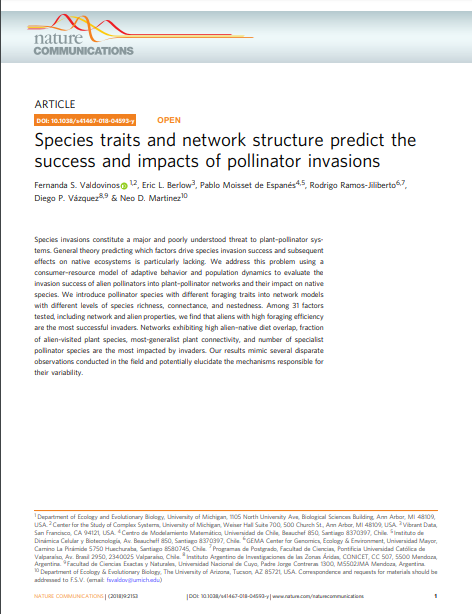Species traits and network structure predict the success and impacts of pollinator invasions

Fecha
2018Autor
Ramos-Jiliberto, Rodrigo [Univ Mayor, Ctr Genom Ecol & Environm GEMA]
Valdovinos, Fernanda S.
Berlow, Eric L.
Moisset de Espanes, Pablo
Vázquez, Diego P.
Martínez, Neo D.
Ubicación geográfica
Notas
HERRAMIENTAS
Acceda a títulos restringidos
¿Cómo descargar?Resumen
Species invasions constitute a major and poorly understood threat to plant-pollinator systems. General theory predicting which factors drive species invasion success and subsequent effects on native ecosystems is particularly lacking. We address this problem using a consumer-resource model of adaptive behavior and population dynamics to evaluate the invasion success of alien pollinators into plant-pollinator networks and their impact on native species. We introduce pollinator species with different foraging traits into network models with different levels of species richness, connectance, and nestedness. Among 31 factors tested, including network and alien properties, we find that aliens with high foraging efficiency are the most successful invaders. Networks exhibiting high alien-native diet overlap, fraction of alien-visited plant species, most-generalist plant connectivity, and number of specialist pollinator species are the most impacted by invaders. Our results mimic several disparate observations conducted in the field and potentially elucidate the mechanisms responsible for their variability.
URI
https://doi.org/10.1038/s41467-018-04593-yhttp://repositorio.umayor.cl/xmlui/handle/sibum/6114
https://www.nature.com/articles/s41467-018-04593-y
Coleccion/es a la/s que pertenece:
Si usted es autor(a) de este documento y NO desea que su publicación tenga acceso público en este repositorio, por favor complete el formulario aquí.